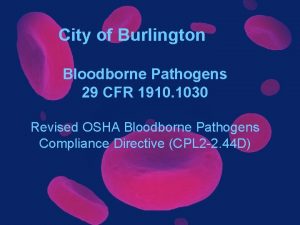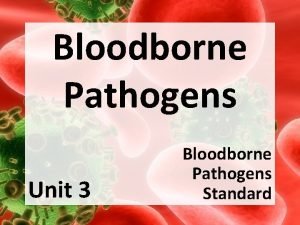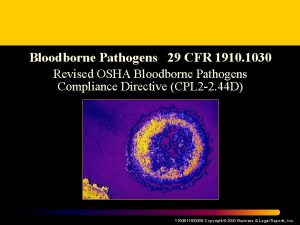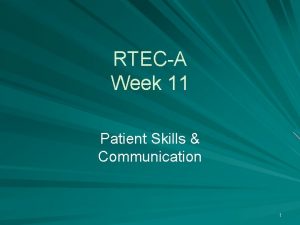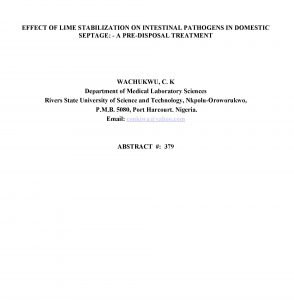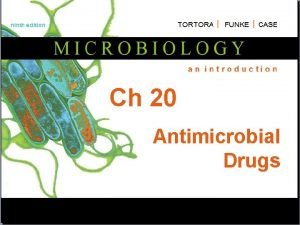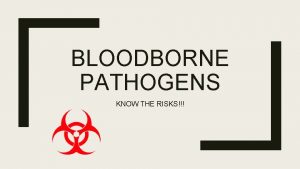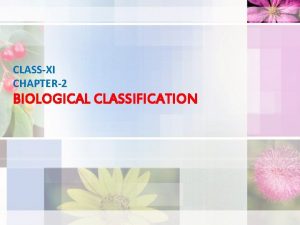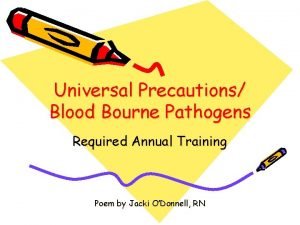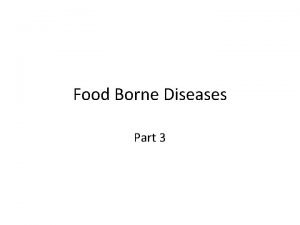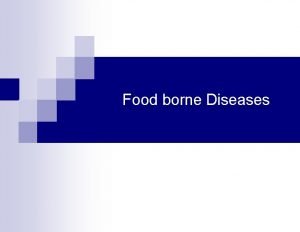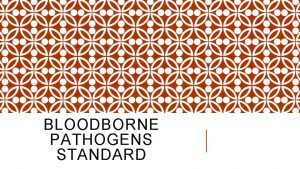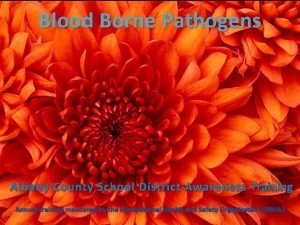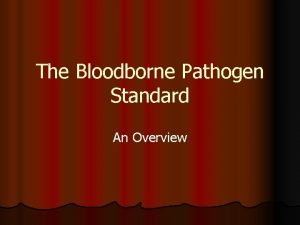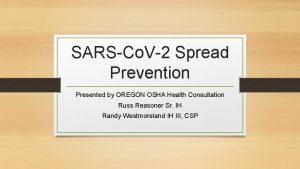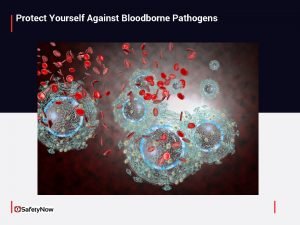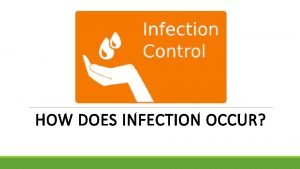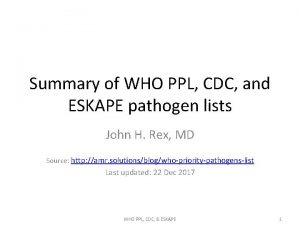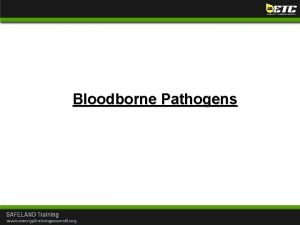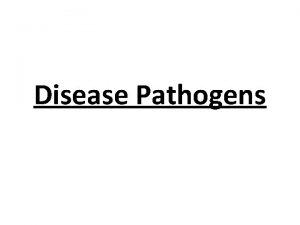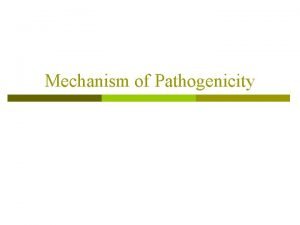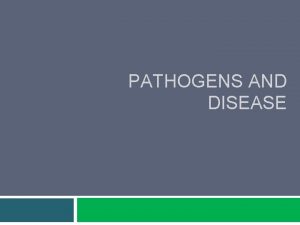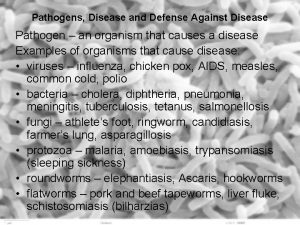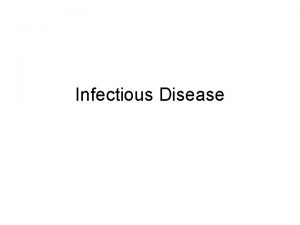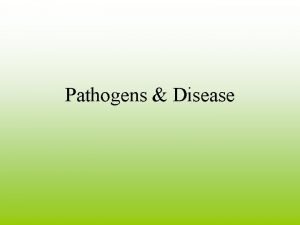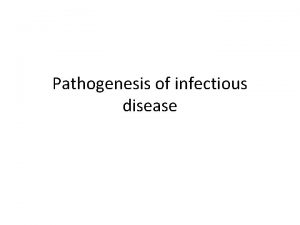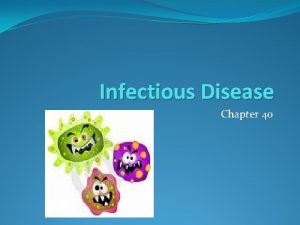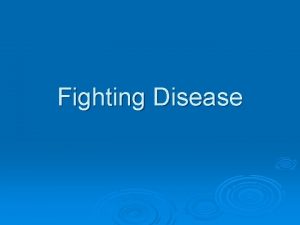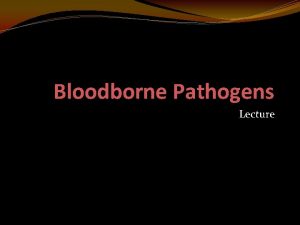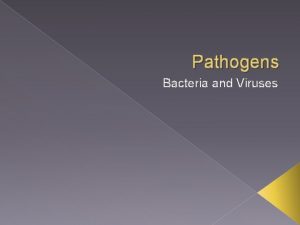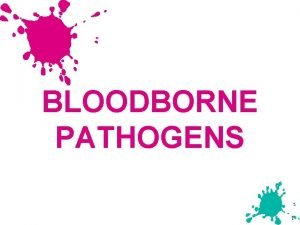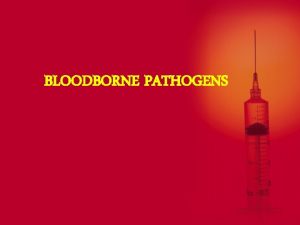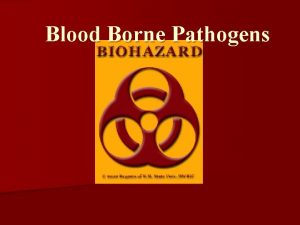Pathogens and Disease What are pathogens l l






















- Slides: 22

Pathogens and Disease

What are pathogens? l l A pathogen is an infectious agent (“germ”) that causes disease or illness in a host. The host is the organism in which a parasite or pathogen does damage.

Key Terms Parasite l Any organism that has a negative effect on another organism with which it has close contact. l All pathogens are parasites.

Key Terms Vector l The item that transfers the pathogen to its host. l Vectors are “vehicles” that transport pathogens from one host to another. l Examples: water, blood, ticks, mosquitoes…

Key Terms Transmission l The passing of disease from an infected individual to unaffected individuals. l Passed by means of a vector.

Key Terms Endemic l A common disease that occurs at a constant, but low, rate in a specific population. l Example: Malaria in Liberia (Africa) is said to be endemic, as it is at a low rate, but constant enough that is it expected that the majority of the population will contract it at some point in their life.

Key Terms Epidemic l When an endemic disease occurs more frequently than expected, in a given area (i. e. Kingston) over a given time period. l Example: The flu would cause an epidemic if more than the usual number of people in a winter got the flu.

Key Terms Pandemic l It is an epidemic of infectious disease that has spread over a larger area (continent, worldwide…). l Examples: HIV/AIDS since 1990, SARS and Avian Flu in the mid 2000 s. Swine Flu in 2010.

What is a Pathogen? Any microbes (organism or virus) that cause disease l Including: l l Viruses l Bacteria l Fungi l Protozoa l Flatworms l Roundworms

Viruses Ebola Considered Non-Living l Two Parts: l l. A Capsid: protein coat l A Nucleic Acid: DNA or RNA HIV Function: Reproduction l Method: Hijack a living host cell and use it’s cellular machinery to replicate and build new virus particles. l

Virus Examples HIV: Human Immunodeficiency Virus l Influenza l Polio l Ebola l Herpes (different simplexes) l

Bacteria Escherichia coli Staphylococcus aureus Most are not pathogenic l All unicellular l Parasitic strains and those that produce toxic byproducts are pathogenic l

Bacteria Examples Streptococcus (Strep Throat) l Escherichia coli l Bacillus anthracis (Anthrax), l Helicobacter pylori (causes peptic ulcers) l

Fungi Decomposers that occasionally don’t wait until an organism is dead to feed on it l Examples: Athletes Foot (skin) l Most are surface/epidermal, some (rarely) become invasive l

Protozoa are unicellular l Pathogenic examples include: l l Giardia l Many vectors have insect Giardia

Flatworms Many are parasitic l Examples include: l l Tapeworms l Flukes (liver fluke) l Schistosoma

Roundworms range in size from macroscopic to microscopic l Many parasitic roundworms inhabit the intestines of a host organism l Examples include: l l Pinworms like Enterobius vermicularis l Hookworms like Necator and Ancylostoma l Trichinella spiralis (larvae migrate to muscle)

Disease Transmission l Direct Contact: Person to person – communicable (mononucleosis) l Kissing l Shaking hands l Touching open wounds or sores l Sexual contact – body fluids

Disease Transmission l Indirect Contact: l Objects – doorknobs, telephones, ect. . . l Air (tuberculosis) l Food (botulism) l Water (typhoid fever) l Vectors l Animal Bites – disease to organism to humans (rabies, West Nile virus)

Disease Transmission Portals of Entry Respiratory Tract – nose, mouth, lungs l Gastrointestingal Tract – throat, stomach, intestines l Mucous Membranes – nose, eyes, etc. l Penetration – bites, cuts, injections l

Opportunistic Pathogens MDR TB and Staph Infections l Malaria (hiding in liver cells) l HIV attacking T-cells and rapid mutation l Influenza and Rhinovirus rapid mutation rate (flu shots every year) l

Prevention/Treatment Options l Antibiotics l Attack existing bacterial infections only l Began with Penicillin (1928 – Fleming) l Resistance observed rapidly l Overuse, Incompletion of Prescription, Livestock application l Vaccinations l Prepare an immune system in advance of a viral (usually) or bacterial infection (i. e. tetanus) l Dead or inactive parts of a pathogen or synthetic
 Antigentest åre
Antigentest åre Bharathi viswanathan
Bharathi viswanathan Human pathogens and toxins act
Human pathogens and toxins act Bloodborne pathogens quiz answers
Bloodborne pathogens quiz answers Unit 3 bloodborne pathogens standard
Unit 3 bloodborne pathogens standard Bloodborne pathogens standard 29 cfr 1910
Bloodborne pathogens standard 29 cfr 1910 Blood borne pathogens
Blood borne pathogens Major human pathogens
Major human pathogens Penicilloic acid
Penicilloic acid Bloodborne flora
Bloodborne flora Bloodborne pathogens know the risk
Bloodborne pathogens know the risk Holozoid
Holozoid Bloodbourne pathogen training
Bloodbourne pathogen training Exposure control plan
Exposure control plan Food borne pathogens
Food borne pathogens Food borne pathogens
Food borne pathogens Exposure control plan bloodborne pathogens
Exposure control plan bloodborne pathogens Bloodborne pathogens awareness training
Bloodborne pathogens awareness training Osha's bloodborne pathogens standard covers
Osha's bloodborne pathogens standard covers Osha safety pyramid
Osha safety pyramid How to protect yourself from bloodborne pathogens
How to protect yourself from bloodborne pathogens An exogenous disease originates outside the body.
An exogenous disease originates outside the body. Eskape pathogens cdc
Eskape pathogens cdc



